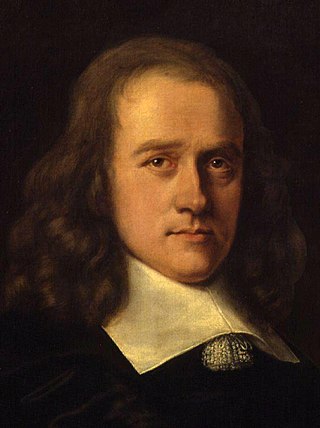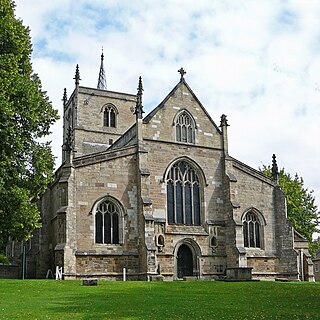Related Research Articles

John Lambert was an English Parliamentarian general and politician. Widely regarded as one of the most talented soldiers of the period, he fought throughout the Wars of the Three Kingdoms, and was largely responsible for victory in the 1650 to 1651 Scottish campaign.

John Thurloe was an English politician who served as secretary to the council of state in Protectorate England and spymaster for Oliver Cromwell and held the position of Postmaster General between 1655 and 1660. He was from Great Milton in Oxfordshire and of Lincoln's Inn,
Sir Richard Willis, 1st Baronet was a Royalist officer during the English Civil War, and a double agent working for the Parliamentarians during the Interregnum.

George Booth, 1st Baron Delamer, was an English landowner and politician from Cheshire, who served as an MP from 1646 to 1661, when he was elevated to the House of Lords as Baron Delamer.

Colonel John Penruddock, of Compton Chamberlayne, was an English Cavalier during the English Civil War and the English Interregnum. He is remembered as the leader of the Penruddock uprising in 1655.

The Penruddock Uprising was a Royalist revolt launched on 11 March 1655, intending to restore Charles II to the throne of England. It was led by John Penruddock, a Wiltshire landowner who fought for Charles I in the First English Civil War; intended as one of a number of co-ordinated risings, the others failed to take place and it was easily suppressed.

Thomas Belasyse, 1st Earl Fauconberg PC was an English peer. He supported the Parliamentary cause in the English Civil War, becoming close to Oliver Cromwell and marrying Cromwell's third daughter, Mary. After the Restoration of the monarchy he became a member of the Privy Council to Charles II and was elevated to an earldom by William III.

Sir Henry Slingsby of Scriven, 1st Baronet, 14 January 1602 – 8 June 1658, was an English landowner, politician and soldier who sat in the House of Commons at various times between 1625 and 1642. He supported the Royalist cause during the Wars of the Three Kingdoms, and was executed in 1658 for his part in a conspiracy to restore Charles II.
Events from the year 1655 in England.

Sir Edward Villiers was an English Royalist soldier and courtier. Part of the powerful Villiers family, he was a friend of Edward Hyde, chief advisor to Charles I and Charles II from 1641 to 1668.
John Dove (−1664/65) was a parliamentary politician during the English Civil War and Interregnum. He has sometimes been numbered amongst the regicides; however, although he sat as a Commissioner in the trial of Charles I at the Painted Chamber of the Palace of Westminster on the 12th, 13th, 19th, and 26 January, Dove took no other part in the trial of Charles, did not sign the death warrant, and he was not punished at the Restoration.

Booth's Uprising, also known as Booth's Rebellion or the Cheshire Rising of 1659, was an unsuccessful attempt in August 1659 to restore Charles II of England. Centred on North West England and led by George Booth, it took place during the political turmoil that followed the resignation of Richard Cromwell as head of The Protectorate.
John Reynolds (1625–1657) was a soldier in the English Civil War and during the Commonwealth. Reynolds may have been a member of the Middle Temple. He joined the parliamentary army, and in 1648 he commanded a regiment of horse. He took part in the Cromwellian conquest of Ireland. He was a member of the Westminster-based Protectorate Parliament for Galway and Mayo in 1654 and Waterford and Tipperary in 1656. He was knighted in 1655. In 1657 he commanded the English force which cooperated with the French in Flanders in the Anglo-Spanish War and was lost at sea when returning to England.
John Clarke, also known as John Clark, John Clerk, and John Clerke, was an English politician and Justice of the Peace who sat in the House of Commons from 1653 through 1660, and was a colonel in the Parliamentary army between 1651 and 1659.
Vincent Gookin (1616?–1659) was an English surveyor-general of Ireland. He represented Irish constituencies in the Protectorate parliaments. In 1655 he published two pamphlets deprecating the enforcement of orders for transplantation of Irish to Connaught. He was a man of strong religious convictions, and an ardent republican.

Thomas Birch, c. 5 June 1608 to 5 August 1678, was an English landowner, soldier and radical Puritan who fought for Parliament in the Wars of the Three Kingdoms, and sat in the House of Commons at various times between 1649 and 1658.
Henry Norwood, of Bishampton, Worcestershire supported the Royalist cause in the English Civil War as a distinguished cavalry officer fighting as a volunteer at Bristol and Worcester. After the defeat, trial and execution of Charles I, he set out on what proved to be a difficult journey to Virginia, where a cousin was governor. He returned to England, became active as an agent attempting to aid Royalist uprisings, and spent a significant time imprisoned in the Tower for his pro-Royalist activities. Upon his release he was involved in Booth's Uprising and, subsequently, acted as a messenger between Charles II of England and Edward Montagu, Earl of Sandwich. He was appointed deputy governor in Dunkirk a little after the Restoration and, when Dunkirk was sold to Louis XIV of France, he was sent to Tangier, where he rose to become governor. He was a Member (MP) of the Parliament of England for Gloucester 20 April 1675. He died in Leckhampton in 1689, and was buried in St Peter's Church, Leckhampton.
Humphrey Mackworth was an English politician and soldier of Shropshire landed gentry origins. He was military governor of Shrewsbury, in succession to his father and namesake, for almost five years under the Protectorate, from 1655 until late in 1659. He represented Shrewsbury in the First, Second and Third Protectorate Parliaments.

Compton Park House is a Grade I listed manor house in Compton Chamberlayne, Wiltshire, England.
References
- 1 2 3 Roberts, Stephen K. (2004). "Sealed Knot (act. 1653–1659)". Oxford Dictionary of National Biography (online ed.). Oxford University Press. doi:10.1093/ref:odnb/98250.(Subscription or UK public library membership required.)
- 1 2 Plant, David (25 August 2008). "The Sealed Knot". BCWProject. Archived from the original on 4 June 2016. Retrieved 24 October 2016.[ better source needed ]
- ↑ Carlton, Charles (2011). This Seat of Mars: War and the British Isles, 1485–1746. Yale University Press. p. 146. ISBN 978-0300180886.
- ↑ Henderson, Thomas Finlayson (1886). . In Stephen, Leslie (ed.). Dictionary of National Biography . Vol. 5. London: Smith, Elder & Co. p. 378.